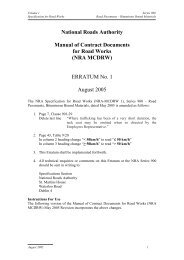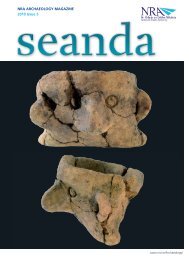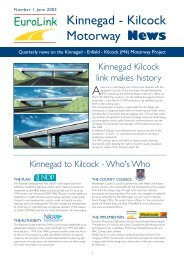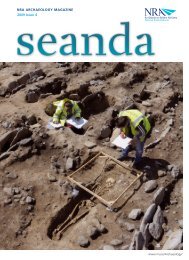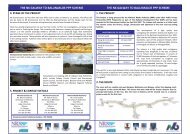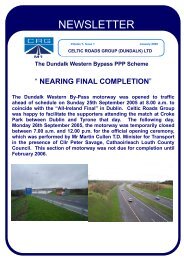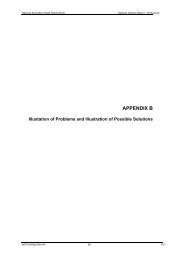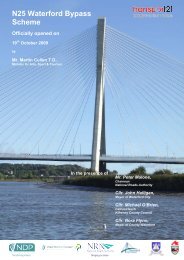ROAD PAVEMENTS – BITUMINOUS BOUND MATERIALS Contents
ROAD PAVEMENTS – BITUMINOUS BOUND MATERIALS Contents
ROAD PAVEMENTS – BITUMINOUS BOUND MATERIALS Contents
You also want an ePaper? Increase the reach of your titles
YUMPU automatically turns print PDFs into web optimized ePapers that Google loves.
Volume 2 Series NG 900<br />
Notes for Guidance on the Specification for Road Works Road Pavements <strong>–</strong> Bituminous Bound Materials<br />
Figure Figure NG NG 9/2: /2: Bituminous Binders for Hot Mix Asphalt - Polymer Modified and and Unmodified<br />
Unmodified<br />
RTFOT<br />
163°C<br />
45 mins<br />
Air<br />
Stainless Steel Screws<br />
Weight loss reported as BS EN 1260-7<br />
'Short Term Aged Binder'<br />
Characteristic eg. G* at 25°C and 0,4Hz<br />
RTFOT<br />
163°C<br />
75 mins<br />
Time<br />
NG NG 924 924 High Friction Friction Surfaces<br />
(Schematic diagram to show procedure)<br />
1 High skid resistant durable surface<br />
treatments are now available which consist of<br />
a thin film of resin based binder sprayed on to<br />
a sound surface and covered with small size<br />
calcined bauxite aggregate of high PSV.<br />
Surface treatments comprising high PSV<br />
aggregates mixed with resin before spreading<br />
on the surface do not comply with the<br />
requirements of Clause 924.<br />
2 Experience has shown these surfacings can be<br />
effective in reducing traffic accidents on sites<br />
where rapid deacceleration can occur<br />
especially if this is coincident with high traffic<br />
density. Typical sites are the approaches to<br />
signal controlled junctions, roundabouts and<br />
pedestrian crossings subject to a heavy flow of<br />
vehicles and high approach speeds.<br />
3 These surfacings require good adhesion to the<br />
underlying strata, and their application can be<br />
weather depedent. In comparison to other<br />
surfacing materials their effective life can be<br />
quite short. They should only be used after<br />
consideration has been given to the use of<br />
cheaper alternative measures such as surface<br />
dressing with a high PSV natural aggregate,<br />
'Aged Binder'<br />
8 hrs 135°C Air<br />
Equivalent PAV/HiPAT<br />
Modified Ageing RTFOT<br />
22 hrs 135°C<br />
End Check<br />
January 2010 21 21<br />
135°C<br />
4 hrs<br />
8 hrs - 'Aged Binder'<br />
22 hrs<br />
Air<br />
Stainless Steel Screws<br />
improved road signs and markings, improved<br />
street lighting, etc.<br />
4 The Specification is based on high skid<br />
resistant surface treatments which have been<br />
proven over a number of years and are known<br />
to give very good skid resistance and a<br />
relatively high level of durability. The<br />
treatment should only be used on surfaces<br />
which are dry, clean, hard and sound.<br />
Surfaces not suitable for treatment include<br />
slurry seals, fatted and multilayer surface<br />
dressings and surface dressings over soft or<br />
unsound bases. Performance on concrete may<br />
not be as good as on bituminous surfacings.<br />
5 Attention is required to ensure the surface is<br />
properly prepared. The surface to which resin<br />
is applied shall be dry and free from dust, oil,<br />
excess bitumen and other contaminant that<br />
may cause lack of adhesion.<br />
6 The level of relative humidity and<br />
temperature affects production rates so levels<br />
should be stated in Appendix 7/1. The<br />
manufacturer's recommendations should be<br />
sought for the particular system in use.<br />
7 The polished stone value test cannot be<br />
carried out on material supplied to site. The






